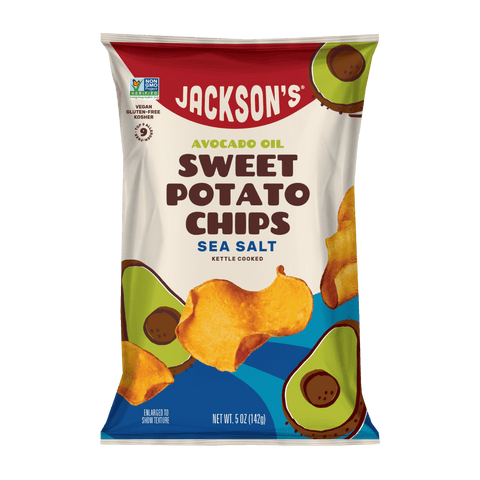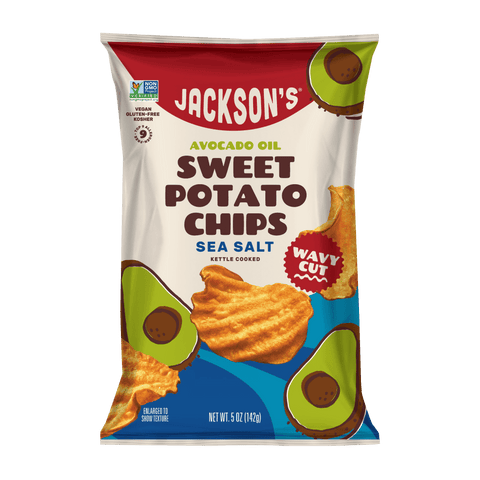A Guide to the Types of Sweet Potatoes

Ever stood in the produce aisle, staring at a pile of sweet potatoes and wondering... are they really that different? Spoiler alert: YES! While they might look similar(ish) on the outside, these amazing tubers come in a surprising range of colors, textures, and flavors hiding beneath the skin. Getting to know them unlocks a whole new world of delicious possibilities in your kitchen, from savory sides to delightful desserts. Let's dive into some of the most popular types you'll likely find at your grocery store and discover your next favorite!
Not only are they delicious as kettle chips, but there are several different types of sweet potatoes. In this guide, we’ll briefly touch on some of the key differences between potatoes and sweet potatoes then dive into the different species of sweet potato.
Are Sweet Potatoes Yams?
Definitely not!
It’s a common misunderstanding though: yams are related to potatoes, but sweet potatoes are related to the morning glory family, Convolvulaceae. Plants that belong to this family are prone to beautiful and abundant flowering!
Sweet potato vines also differ from regular potato vines. The sweet potato has vines that grow quickly along the ground and the vines will also crawl along strings if a vertical garden is used. Generally, the leaves are a darker greenish purple, and the flowers look very similar to a pink morning glory.
On the other hand, regular potatoes don’t form lengthy vines and instead they tend to push upwards and continually grow additional tubers along their stem if taken care of. The leaves are also light green and are far less angular than sweet potato leaves.
Sweet potatoes originated in Central and South America as early as 8,000 B.C. as both a food source and decoration. Not only are sweet potatoes packed full of nutrients, but the juice from crushed sweet potatoes can also be used as a dye. That’s not all! Sweet potatoes are also used to make inks, glues, and rubber. They are truly superheroes!
Types of Sweet Potatoes

Below, we cover the differences between the many species of sweet potato. Varieties can differ greatly in taste, size, texture, and color.
‘A’
Amish Bush Porto Rico
Amish Bush Porto Rico is a bush type of sweet potato that can be grown in a small amount of space. They are especially handy in the garden since they retain the typical ivy shape leaves and are particularly resistant to pests. They can grow well in a pot or in the ground and they will grow in easily manageable clusters.
Compared to other sweet potatoes, this variant tastes sweet and buttery when it is cooked. It can have a light pinkish color to its skin or it may be more on the copper end of the spectrum. What does remain consistent is the flesh: regardless of the skin color, Amish Bush Porto Rico consistently has red-orange flesh.
Apache
Unlike other species, the Apache is at the beginning of the color spectrum with its light tan and red skin and flesh. It tends to have a waxy texture on the outside of the tuber, and it must be scrubbed clean before eating. Unlike the buttery flavor of the Amish Bush Porto Rico, the Apache has a smooth, sweetened chestnut flavor.
The most striking fact regarding Apache sweet potatoes, is the many patterns they can have. The skin has patches of white and red skin and the flesh can have red speckles throughout; they are small powerhouses that pack a punch. If you are serving them and want to keep the distinct Apache Sweet Potato pattern, then blanch the potatoes before fully cooking them.
‘B'
Batata
The Batata is a great all-around variety. It is grown mainly in the Caribbean: the species is frequently used as an addition to soups and stews. With a slightly sweet and starchy flavor, the Batata also works well boiled or mashed.
Beauregard
Ah, the Beauregard! This is often the quintessential sweet potato many of us picture. Look for: Its familiar light purple/rose-gold skin and vibrant, deep orange flesh. Taste & Texture: Reliably sweet with a wonderfully moist, slightly fibrous texture when cooked – perfect for that classic sweet potato experience! Best For: It's a fantastic all-rounder! Think classic Thanksgiving casseroles (marshmallows optional!), silky smooth purees, roasting into caramelized wedges, or baking whole until fluffy and tender.
‘C’
Camote
Camote (pronounced kah-moh-teh) are a native species of sweet potato that grows in the tropical regions or Mexico as well as some parts of America. This species is theorized to have been a key part of the Mayan diet: it is now a prominent variety included in Mexican culinary culture.
Camote, which is the Spanish word for sweet potato, is often sold by street vendors in Mexico. You can find them fresh and plain or sweetened with sugar, cinnamon, and honey.
Centennial
Centennials are the color of a shiny penny with equally stunning flesh, decadent moisture, and sweet flesh. With their moisture content, they can be used to add moisture to cakes and other pastries or breads. Since Centennials can be used in any type of dish, they are a favorite for home gardeners.
Compared to other species, Centennials have a more carrot-like shape, and they are also short-season growers. If you want to have delicious Centennials, then make sure you harvest them prior to the first frost: they don’t do that well in the cold.
Charleton
If you really want to eat the rainbow, then you have to include Charleton sweet potatoes in your diet. While the skin is a drab brown, the skin hides beautiful almost neon purple flesh. The intense color is not followed by an intense flavor. In fact, many refer to the Charleton as a very balanced sweet potato.
Unlike the majority of sweet potatoes, the Charleton has a drier texture and is better used as a colorful addition to dishes. Rather than being the main star, the Charleton can add balanced flavor to many dishes and help reduce the intensity of other flavors. As with most sweet potatoes, the Charleton has a host of antioxidants that are important for your body.
Cilembu
Cilembu is the queen of poster child sweet potatoes. If you are looking for potatoes that naturally glaze when you cook them, then this is the species for you. Versatile and sweet, the Cilembu is named after a small village in Indonesia where the species was first recognized.
Cilembu’s vary in size from one to four pounds. In order to get these gigantic sweet potatoes to grow, they have to be at least 1000 meters above sea level with the perfect amount of rain. The only word of warning with the Cilembu is don’t boil or steam them: they will easily lose their hint of sweetness.

Covington
Convingtons find their home in North Carolina where they make up almost 85% of the sweet potatoes produced in the area. This species is a favorite among southerners because of its moist and creamy texture. They are easy to peel and roast in an oven if you have the patience to wait for a bite of malty sweet sweet potato.
This species boasts bright orange flesh even when cooked. They are easily definable by their rose colored skin with tiny spots. Tapered ends, and a slight curve make the potatoes look a little like the moon. You can eat them with any combination of savory herbs and spices, or you can serve them plain. Some may also enjoy this species as a raw, bright addition to any salad.
Creamsicle
There’s not much on the Creamsicle other than praise for its startling combination of creamy skin, and vibrant orange flesh. Since it is a firmer species, these do well with frying or boiling.
Crown Jewel
The Crown Jewel is the color of true royalty: deep, vibrant purple. The entire potato can be used, however the interior is often waxy and dense. Once cooked, the waxiness breaks down. The most usable part of this potato is the outer later (usually pale purple or white): it is softer, smoother, and more flavorful.
Like many purple varieties, the Crown Jewel has tons of antioxidants and nutrients. Because of their texture and taste, Crown Jewel does well when it is fried. The sweet and crunchy snack that results from frying or air frying is something you won’t ever forget.
‘E’
Envy
Envy is a short, sweet, and to the point species. They are an heirloom species which inherently makes them hardier than other species. These types of potatoes can be used for baking, roasting and casseroles. Envy is not as sweet as other species, but their moisture and flavor make them great additions to stews and roasts.
Evangeline
Thank you Louisiana for this substantial, nutritious, and sweet potato. Unlike others in the sweet potato family, the Evangeline contains more sucrose than other potatoes: most potatoes are full of maltose which is a starchier sugar. A super sweet flavor can’t hide the fact that the Evangeline contains 40% more Vitamin A then other varieties!
Since they are resistant to the most common disease, Evangelines are a friend to many gardeners. In storage, their red skin will fade to more of a rosy color, however the flesh will maintain its vibrant orange color.
‘G’
Georgia Jet
Georgia Jet are another early season potato with a very high yield. They have prominent red skin with sweet and tender orange flesh. Unlike many sweet potatoes that enjoy heat, the Georgia Jet prefers cooler weather. Jets are hardly grown in warmer areas, but they can be found further south.
Ginseng Red
Talk about a red potato! The Ginseng Red almost has ruby skin. The leaves of this semi-bush variety are like a hand with fingers stretched out which is the typical ivy shape. Sweet golden flesh and high nutrient levels make this variant a favorite.
If you plan on growing Ginseng Red, keep in mind that they need warm weather. Wait to harvest the tubers in their prime during spring and summer.
‘H’
Hannah
Stepping away from the orange crowd, let's talk about the wonderful Hannah! Look for: A light tan, almost creamy-colored skin, similar to a classic potato, but don't be fooled! Inside you'll find a lovely pale yellow or cream-colored flesh. Taste & Texture: When cooked, Hannahs become wonderfully firm, dense, and pleasingly dry compared to their orange cousins. Their sweetness is present but leans towards a milder, more subtle flavor profile. Best For: If you love a potato that holds its shape, Hannah is your friend! It's perfect for cubing and roasting until crisp, slicing into sturdy fries or wedges, or adding to stews and curries where you don't want it to turn mushy. It's a great 'bridge' potato for those who find traditional sweet potatoes too sweet.
Hayman
Haymans are fascinating sweet potatoes since they have greenish-yellow flesh and milky white skin. Unlike White Hayman sweet potatoes, Haymans are sweeter and far moister. They come from Barbados and became popular along the east coast region.
Farmers often avoid the Hayman due to its low yield and ugly, gnarled shape. Even though it is a pain to grow, this sweet potato has a delicious honey-like sweetness that you will fall in love with after the first bite.
Hernandez
Yet another gift from Louisiana! Thanks to Louisiana State University, the Hernandez variety is a sweet potato with light red skin, and the characteristic moist orange flesh. Unlike many hand-selected species, the Hernandez has large root systems. As with most sweet potatoes, Hernandez sweet potatoes do well baked, roasted, in soups, or fried.
‘J’
Japanese White Satsuma-Imo
The Japanese sweet potato (often called Satsumaimo) is a game-changer if you're used to orange varieties. Look for: Its distinctive purplish-red skin guarding a creamy, pale yellow flesh inside. Taste & Texture: Forget watery – this one cooks up much drier, fluffier, and denser. It boasts a unique, concentrated nutty sweetness, often compared to chestnuts – truly satisfying! Best For: Simply roasting or steaming is phenomenal, letting its amazing texture and flavor shine. It's also incredible sliced and baked into 'fries,' added to stews, or even used in traditional Japanese desserts.
Jersey
Jersey sweet potatoes are another white flesh variety with golden-yellow skin. Because they are a drier sweet potato, they will work well in dishes that have sauces or soups and stews.

Jewel
Meet the Jewel! Often vying for the top spot alongside the Beauregard, this one's a real gem (pun intended!). Look for: A lovely copper-colored skin, often slightly smoother than a Beauregard, revealing a bright orange interior. Taste & Texture: Jewels offer a dependable, moist texture when cooked and a delightful sweetness that's super versatile. They hold their shape slightly better than some other orange varieties during cooking. Best For: Another fantastic all-purpose potato! Jewels shine when baked, mashed, or roasted. Their slightly firmer texture makes them great candidates for cubing and adding to hashes or sheet pan dinners, and they make a mean sweet potato pie filling!
‘K’
Korean Purple
Korean Purple Sweet potatoes are another heirloom variety. These purple skinned potatoes can always be found during the fall in Korea as they are a popular fall and winter snack. Generally, they are wrapped in foil and tossed into a fire until they are cooked through. The flavor of the yellowish meat is like a sweet chestnut.
If you want to add the Korean Purple to a dish, it is best to fry or sauté them in order to keep the purple color of the skin. Speaking of the skin, Korean Purple sweet potatoes contain anthocyanins which is the same antioxidant that is in blue berries!
Kotobuki
The Kotobuki is the first in this list to have more of a reddish flesh than other sweet potatoes. They are not often used outside of stir-fry, tempura, or other cooking processes that add fats to the potato.
Related: Sweet Potatoes and Diabetes
Kumara
As the third most popular vegetable in New Zealand, the Kumara boasts a vast history. Originally, the species was brought to the pacific islands by the Maori people. Like how Camote means ‘sweet potato’ in Spanish, Kumara is the Maori word for sweet potato.
There are a few variations of the Kumara: red, gold, and orange. They have different sweetness levels with the orange Kumara being the sweetest. Each variation is used frequently as mashed potatoes, barbecued potatoes, and salad toppings. They also go great with fruits like pineapple and apricots!
‘M’
Murasaki (Japanese Sweet Potatoes)
Murasaki are medium to large and very oblong in shape. They have a purple-red skin with crisp white flesh. Unlike many potatoes, Murasakis have a more floral taste than others. When cooked low and slow, Murasaki gain a silken texture which is a wonderful addition to sauces or as a thickening and moisture adding agent for baking. Even though the name suggests foreign origins, the Murasaki originates at LSU and it is primarily grown in California.
‘N’
Nancy Hall
Nancy Hall sweet potatoes are often considered to be ugly sweet potatoes. Even though their flavor is sweet, the texture is moist, and cooking needs are varied, Nancy Hall potatoes are often an ignored variant. An interesting tidbit about the Nancy Hall is that the potatoes are often stored in hothouses which allows them to develop a more firm, moist, and sweet flesh.
North Carolina
North Carolina sweet potato are from the state itself and they are known for their high quality. The flesh is a bright orange and the skin is a lovely russet. They maintain the status quo with their flavor and grow to healthy medium-large sizes.
Nugget
Like the Cilembu, Nugget is a prime potato for roasting and glazing. They are distinctly dense and hold their shape well. To identify them, the Nugget sweet potatoes are rosy-skinned with orange flesh.

‘O’
O’Henry
O’Henry Sweet Potato is a hybrid species that has a slightly sweet taste, with firm and dense flesh. When cooked properly, the O’Henry takes on a creamy texture which makes it yet another great all-around tuber. While other white flesh sweet potatoes have a hard time with disease, this reddish skinned sweet potato is far more resistant than it’s fellow white sweet potatoes.
Okinawa (Hawaiian Sweet Potatoes)
Okinawa sweet potatoes are nothing surprising to look at … externally. Once you cut open an Okinawa sweet potato, your life will never be the same. The inside of the potato is an extremely intense color of purple: this deep purple makes it one of the darkest, most dense, and nutrient heavy sweet potatoes available.
Their texture is grainier when uncooked. However, once they are cooked, they are soft and sweet enough to be included in many different main dishes and desserts. Perhaps the most impressive feature is that Okinawa sweet potatoes don’t lose their color when they are baked!

‘R’
Red Garnet
The Red Garnet is truly a gem to look at. With dark reddish orange skin and bright orange flesh to contrast, these sweet potatoes are the perfect potato for baking. Since Red Garnets are moister than Jewels and Beauregards, they can be used as a substitute in many recipes. The flavor of a Red Garnet is often compared to squash rather than a sweet potato; this makes them the perfect addition to any soup, stew, or any casserole.
Regal
Regal sweet potatoes are another species with dark purple-red skin and orange flesh. They are a high-quality potato with a large yield. Generally, Regal sweet potatoes will do best when used for baking.
‘S’
Southern Delight
Southern Delight sweet potatoes are very direct: they have dark orange flesh and dark copper skin. They have a mild flavor and store much like regular sweet potatoes.
Read: National Sweet Potato Day!
Speckled Purple
If you are looking for a flashy variety of sweet potato, then the Speckled Purple sweet potato is what you want. Light flecks mark magenta flesh and they are a firmer species that work best when fried.
Stokes Purple®
Prepare for a visual stunner! The Stokes Purple® (and other similar purple varieties) are as gorgeous as they are tasty. Look for: A vibrant, deep purple skin and equally vibrant purple flesh – yes, purple all the way through! Taste & Texture: These beauties tend to be denser and drier than orange types, similar to Japanese sweet potatoes, but with their own unique flavor. Expect a rich, complex sweetness, sometimes with subtle floral or wine-like notes. Best For: Show off that incredible color! Roasting or baking them whole or as wedges really highlights their beauty. They make incredible purple pies, striking purees (imagine vibrant purple hummus!), or eye-catching additions to salads and grain bowls. Their drier texture also makes them excellent for homemade gnocchi or adding structure to baked goods.
Sumor
Sumor, or ‘summer’, sweet potatoes have more vitamin C than other sweet potatoes. They are energetic growers and love the heat. With high production rates, beautiful light tan skin and yellow flesh, the Sumor is a less sweet potato that grows well and tastes delicious.
‘T’
Tahitian
Unlike other varieties that can be easily identified, Tahitian sweet potatoes come in a vast array of colors, shapes, and sizes. Each color and shape depend on how the farmer took care of the potatoes. They are generally bulbous and have thin purple skin with white flesh. When baked, Tahitian sweet potatoes take on a creamy texture and they can also caramelize well thanks their sugar content.
‘V’
Vardaman
Another bush garden variety, the Vardaman is a great sweet potato to grow if there is limited taste. Historically, they have been around since the 1980’s when they were used as ornamentals and food. Vardaman’s have jumbo roots and golden skin that hides a deep orange-red flesh.
‘W’
West African
West African sweet potatoes are one of the most relied on staple foods in Africa. Both the flesh and skin are cream colored, but the flesh can be very sticky and starchy. As it cooks, the West African sweet potato gets a fluffy texture with a nutty flavor.
The West African sweet potato is an all day, any day food that goes well in soups and stews. Citizens of Africa often boil the potato since its structure can withstand the water. An added bonus? The leaves of the West African sweet potato can be used to ease asthma and upset stomach symptoms!
Willowleaf
Willowleaf sweet potatoes are very hard to come by. They are an heirloom variety with reddish skin and orange, nutty flesh.
‘Y’
Yamaimo
Just like the West African Sweet Potato, the Yamaimo is another sticky sweet potato. They can be used to make soba noodles and are often added to salads as a sweet side.
Conclusion
Wow, who knew sweet potatoes had so many unique personalities? From the familiar comfort of a Beauregard to the surprising nuttiness of a Japanese variety and the stunning vibrancy of the Stokes Purple, there's truly a sweet potato out there for every dish and every palate. The absolute best way to find your personal favorite? Get experimenting in the kitchen! Don't hesitate to grab a new-to-you type next time you're shopping. Roast them, mash them, bake them whole, or slice them into diy sweet potato chips – explore all the incredibly delicious ways to enjoy these versatile, nutrient-packed gems.
No Seedy Oils Here
Avocado Oil Goodness Meets Irresistible Flavor - No Seed Oils Here!
-

 8 Pack Best SellerSea Salt Sweet Potato Chips in Avocado Oil 5oz (Pack of 8)
8 Pack Best SellerSea Salt Sweet Potato Chips in Avocado Oil 5oz (Pack of 8)Sea Salt
Sweet Potato Chips in Avocado Oil
- Size
- 5oz bags
- Regular price
- $35.99
- Sale price
- $35.99
- Regular price
-
$35.99 (Liquid error (snippets/product-price line 131): divided by 0 per bag) - Unit price
- per
-

 8 PackWavy Sea Salt Sweet Potato Chips in Avocado Oil 5oz (Pack of 8)
8 PackWavy Sea Salt Sweet Potato Chips in Avocado Oil 5oz (Pack of 8)Wavy Sea Salt
Sweet Potato Chips in Avocado Oil
- Size
- 5oz bags
- Regular price
- $35.99
- Sale price
- $35.99
- Regular price
-
$35.99 (Liquid error (snippets/product-price line 131): divided by 0 per bag) - Unit price
- per
-

 8 Pack New Arrival!Sea Salt Kettle Chips in Avocado Oil 5oz (Pack of 8)
8 Pack New Arrival!Sea Salt Kettle Chips in Avocado Oil 5oz (Pack of 8)Sea Salt
Kettle Chips in Avocado Oil
- Size
- 5oz bags
- Regular price
- $35.99
- Sale price
- $35.99
- Regular price
-
$35.99 (Liquid error (snippets/product-price line 131): divided by 0 per bag) - Unit price
- per
-

 8 Pack New Arrival!Variety Pack Kettle Chips in Avocado Oil 5oz (Pack of 8)
8 Pack New Arrival!Variety Pack Kettle Chips in Avocado Oil 5oz (Pack of 8)Variety Pack
Kettle Chips in Avocado Oil
- Size
- 5oz bags
- Regular price
- $35.99
- Sale price
- $35.99
- Regular price
-
$35.99 (Liquid error (snippets/product-price line 131): divided by 0 per bag) - Unit price
- per








